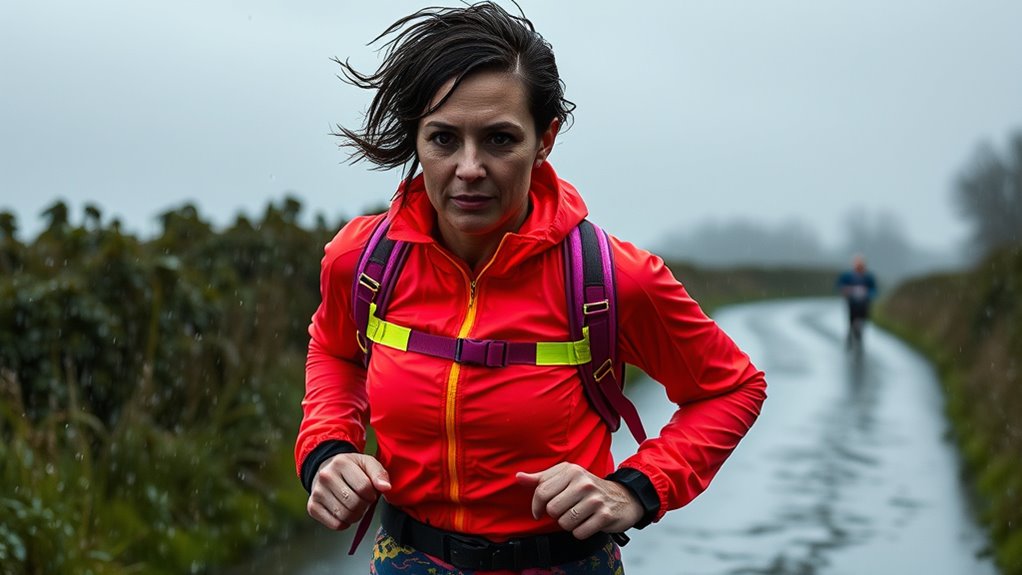Running a rain-soaked 10K PB shows you the importance of embracing unexpected challenges and staying flexible. You learn to adapt your pace, choose proper gear, and focus on mental resilience, turning rain from a obstacle into an opportunity. By adjusting your mindset and strategies, you push through discomfort and slip risks, celebrating your achievement. Keep exploring how weather shapes your running journey, and you’ll uncover even more ways to excel in any conditions.
Key Takeaways
- Embracing the rain as a challenge boosted mental resilience and made the race feel more rewarding.
- Proper waterproof gear and adjusted pacing helped maintain safety and energy levels in wet conditions.
- Training in variable weather improved adaptability, preparing me for unpredictable race day environments.
- Focusing on steady hydration and nutrition prevented fatigue despite the rain and slippery surfaces.
- Staying positive and focused turned the downpour into an opportunity for personal growth and achievement.
Embracing the Unexpected: The Day the Rain Started

As you step onto the course, the sky suddenly darkens and rain begins to fall unexpectedly. You feel a rush of surprise, but it’s essential to adopt a rainy mindset right away. Instead of panicking, you focus on weather adaptability—adjusting your pace and mindset to the wet conditions. Embracing the rain means accepting that the day’s plan has changed, and that’s okay. You realize that unexpected weather can test your mental toughness, pushing you to stay calm and focused. Additionally, embracing preppy dog names can reflect a positive and stylish attitude, even in adverse conditions. Instead of fighting the elements, you lean into them, seeing the downpour as a challenge rather than a setback. This shift in perspective helps you stay present, motivated, and ready to tackle the course, rain or shine. Recognizing the importance of weather conditions can help you better prepare for and adapt to unforeseen challenges during your game. Moreover, understanding that fatherhood involves resilience and support can inspire you to stay committed and positive despite setbacks. Additionally, incorporating diverse plant designs in your surroundings can create a more resilient and inspiring environment, much like adapting to unpredictable weather.
Rethinking Preparation: Training for All Conditions

To perform well in any weather, you need to train across different conditions, not just on clear days. Adjust your gear and strategies to stay comfortable and efficient, no matter what Mother Nature throws at you. Building mental resilience helps you stay focused and confident, even when the rain starts pouring. Incorporating weather-resistant gear into your training can make a significant difference in handling unexpected weather challenges. Additionally, familiarizing yourself with operation hours of nearby entertainment venues can help you plan your recovery or leisure activities around your training schedule and weather conditions. Understanding renewable energy sources can also inspire you to adapt your training environment to sustainable practices, such as using solar-powered devices during outdoor sessions. Utilizing natural materials like wood and linen in your gear or surroundings can further enhance your adaptability and comfort in diverse weather conditions.
Embrace Variable Weather Training
Training exclusively in perfect weather conditions can leave you unprepared for the unpredictable nature of race day. To truly perform well in any weather, incorporate variable conditions into your training. Run in rain, wind, or heat to build resilience and adapt your hydration strategies accordingly. Practice maintaining proper hydration and nutrition timing during different weather scenarios, so your body stays fueled and hydrated regardless of external factors. This approach helps prevent surprises on race day, like dehydration or fatigue caused by unexpected weather. Additionally, understanding the importance of personal finance management can help you allocate resources for specialized training or gear needed for adverse conditions. By exposing yourself to diverse conditions, you’ll develop mental toughness and a better understanding of how your body responds. Incorporating simulated adverse conditions can further enhance your preparedness for unpredictable races. Embracing variable weather training guarantees you’re ready to handle whatever race day throws at you, rain or shine.
Adjust Gear and Strategies
Adjusting your gear and strategies is key to maintaining peak performance when weather conditions change unexpectedly. Investing in reliable rain gear—like waterproof jackets, gloves, and shoes—keeps you dry and comfortable, reducing distraction and fatigue. It’s also essential to adapt your pacing and tactics; in rain, conserve energy early and stay relaxed to prevent slipping or overexertion. Mental toughness plays a pivotal role here, helping you stay focused and positive despite the wet conditions. Recognize that your usual strategies might need tweaks, like shorter strides or increased cadence, to stay safe and efficient. By being prepared with appropriate gear and flexible tactics, you can turn challenging weather into an advantage rather than an obstacle.
Build Mental Resilience
Building mental resilience begins with rethinking how you prepare for different weather conditions. Instead of solely focusing on physical training, emphasize developing mental toughness and emotional resilience. Visualize running in rain or wind, so you’re less caught off guard during actual conditions. Practice mindfulness and positive self-talk to strengthen your mindset against setbacks. Embrace discomfort as part of your training, knowing it builds endurance beyond physical stamina. When you face unpredictable weather, your mental resilience helps you stay focused and adaptable. Recognize setbacks as opportunities to grow stronger mentally. By conditioning your mind to handle all conditions, you’ll boost your confidence and reduce anxiety during race day. Ultimately, resilient minds turn adverse weather from a barrier into a stepping stone for success.
The Power of Mindset: Staying Focused When It’s Wet and Wild

When the rain starts pouring and the course becomes slick, your mindset becomes your most powerful tool. Maintaining mental toughness is essential; it helps you push through discomfort and stay optimistic despite the chaos around you. Focus strategies become crucial—concentrate on your breathing, your stride, and the finish line, blocking out distractions. Remind yourself that challenging conditions are temporary, and your training has prepared you for this moment. Embrace the rain as part of the challenge rather than an obstacle. Your ability to stay focused under pressure can make the difference between a good race and a great one. Cultivating a resilient mindset keeps you engaged, motivated, and ultimately, closer to that personal best.
Gear Up: Choosing the Right Clothing and Accessories

Your mindset can carry you through tough conditions, but choosing the right clothing and accessories guarantees you stay comfortable and focused during a rain-soaked race. Invest in reliable rain gear designed for weather resilience—think lightweight waterproof jackets, moisture-wicking shirts, and quick-drying shorts. Opt for breathable materials that prevent chafing while keeping you dry. A well-fitting hat or visor helps shed rain from your face, maintaining visibility. Consider waterproof gloves if the temperature drops, and choose shoes with good traction to prevent slipping. Accessories like a sweat-resistant headband or a running belt can keep essentials dry. Proper gear minimizes discomfort and distraction, allowing you to stay steady and confident, no matter how heavy the rain falls.

To stay safe on slippery streets during a rainstorm, you need to choose proper footwear with good traction. Keep an eye out for puddles that could hide hazards or cause you to slip. And don’t forget to maintain your visibility by wearing bright or reflective gear so others can see you clearly.
Proper Footwear Choices
Choosing the right footwear is essential for safely maneuvering wet, slippery streets during a downpour. Your goal is to maintain grip and stability while avoiding slips. Consider trail running shoes with aggressive tread patterns for better traction, or opt for waterproof sneakers designed for wet conditions. If you prefer barefoot running, make certain your surface is safe and familiar to prevent falls. Here’s a quick comparison:
| Feature | Trail Running Shoes | Barefoot Running |
|---|---|---|
| Traction | High grip | None, depends on surface |
| Waterproofing | Yes | No |
| Flexibility | Moderate to high | Very high |
Proper footwear choices can make a significant difference in safety and performance in rain-soaked conditions.
Watch for Puddles
While selecting appropriate footwear helps you stay stable, remaining alert to your surroundings is key when maneuvering wet streets. Watch for puddles ahead and plan your steps to avoid water splash and slipping hazards. Puddle avoidance isn’t just about staying dry; it’s about preventing slips that can throw off your rhythm or cause injury. Scan the pavement as you run, especially in areas where water may obscure uneven surfaces or debris. If you see a large puddle, consider adjusting your path slightly to bypass it safely. Remember, water splash from puddles can also soak your shoes and clothes, making you colder and more uncomfortable. Staying vigilant ensures you maintain traction and control, helping you stay safe in the downpour while keeping your pace steady.
Maintain Visibility
When running in heavy rain, maintaining visibility is essential for your safety. Wear bright or reflective gear to guarantee you’re seen by drivers and other runners. Keep your headlamp or flashlight steady, and avoid looking down too much to stay aware of your surroundings. Good hydration strategies help you stay alert and focused, which is crucial in slippery conditions. Pace management becomes vital—slow down to prevent slips on slick surfaces and give yourself extra time to react. Regularly check your route for puddles or obstructions, and stay vigilant of vehicles that may have reduced visibility. Clear visibility keeps you aware of hazards, allowing you to adjust quickly and avoid accidents. Staying visible and alert is your best defense against slipping and other rain-related hazards.
Finding Joy in the Challenge: Staying Positive Amidst the Rain

Running in the rain can be intimidating, but it also offers a unique opportunity to find joy in the challenge. Embracing a mindset shift helps you see past discomfort, turning each step into growth. Staying positive amidst the downpour boosts emotional resilience, making the experience rewarding rather than formidable. Focus on the rhythm of your breath and the sound of raindrops; these small moments can lift your spirits. Remember, it’s about perspective—what feels like a setback can become a source of strength. Here’s how your emotions might fluctuate:
| Feeling | Why It Happens | How to Reframe |
|---|---|---|
| Frustration | Wet clothes, slow pace | View it as perseverance |
| Excitement | Unexpected adventure | Celebrate your resilience |
| Calm | Rhythmic breathing | Embrace the present moment |
| Determination | Overcoming elements | Focus on your commitment |
| Joy | Surpassing limits | Recognize your growth |
Pacing Under Pressure: Adjusting Strategies When Wet

Running in wet conditions demands quick adjustments to your pacing to maintain energy and avoid burnout. You should monitor your hydration strategy carefully, as rain can mask thirst signals and increase dehydration risk. Take small, frequent sips if possible, rather than waiting until you’re thirsty. Nutritional planning also plays a crucial role; opt for easily digestible gels or snacks to sustain energy without causing discomfort. Slowing your pace slightly can help conserve energy while preventing fatigue from overexertion. Be mindful of your body’s signals—if you feel yourself pushing too hard, ease up. Adjusting your pace based on weather conditions, hydration, and nutrition keeps you steady and focused, helping you avoid the pitfalls of overexertion in challenging, rain-soaked conditions.
The Moment of Triumph: Crossing the Finish Line

As you cross the finish line, you feel a rush of pure victory. Overcoming the rain and tough conditions makes this moment even sweeter. It’s a proof to your resilience and the thrill of conquering challenges.
The Euphoria of Victory
Crossing the finish line after a grueling 10K in pouring rain is an electrifying moment that floods you with pure euphoria. Your running cadence, once steady, now feels unstoppable as adrenaline surges through you. Every stride, despite the rain, pushes you closer to victory. You’ve managed your hydration strategies well, maintaining focus and energy despite the wet conditions. The sense of achievement washes over you—every mile, every challenge, all worth it. The rain, which threatened to derail your race, now seems like a badge of honor. In that instant, the pain and effort fade, replaced by an overwhelming sense of triumph. It’s a moment you’ll cherish, proof of your resilience and determination amidst the storm.
Overcoming Weather’s Challenge
When the rain pelts down harder and the wind picks up, it’s easy to feel like giving in, but you push forward, determined to reach the finish line. To overcome weather’s challenge, you rely on solid hydration strategies—sipping water consistently to prevent dehydration, even in the rain. Race day nutrition also plays an essential role; a quick carbohydrate gel or electrolyte drink keeps your energy steady and your muscles functioning. You focus on maintaining a steady pace, ignoring the discomfort and distractions. Remember, mental resilience is key. By staying disciplined with hydration and nutrition, you guarantee your body stays fueled and hydrated, helping you cross that finish line strong despite the downpour. Victory comes from perseverance, even when weather seems against you.
Lessons Learned: How Rain Changed My Running Perspective

Rain can drastically alter your running experience, forcing you to adapt both physically and mentally. It encourages you to embrace rain reflections, noticing how wet pavement mirrors the gray sky, reminding you to stay present. Puddle adventures become inevitable, turning mundane stretches into playful challenges—leaping over or splashing through water with purpose. These moments teach you patience and adaptability, shifting your focus from speed to mindfulness. Running in rain reveals that obstacles can be opportunities for creativity and resilience. It pushes you to rethink your perceptions of comfort and control, showing that setbacks like wet gear or slippery surfaces aren’t barriers but parts of the journey. Ultimately, rain changes your perspective, making you more flexible and appreciative of the unpredictable beauty in every run.
Applying the Experience: Preparing for Future Races in Any Weather

Preparing for future races in any weather starts with mindset and planning. You should develop adaptable hydration strategies that account for rain, wind, or cold, ensuring you stay hydrated without overdoing it. Practice your race day nutrition in various conditions so your stomach remains stable regardless of weather. Consider carrying waterproof gear or clothing that helps regulate temperature and keeps you comfortable. Adjust your expectations and pacing to match weather forecasts, staying flexible if conditions worsen. Use your rain experience to refine your mental toughness, knowing you can push through challenging weather. By preparing with specific hydration and nutrition plans, along with appropriate gear, you set yourself up for success no matter what Mother Nature throws your way.
Frequently Asked Questions
How Did Training in the Rain Improve My Overall Running Performance?
Training in the rain helps you adapt to various weather conditions, making you a more resilient runner. Rain training improves your grip, balance, and mental toughness, so you’re better prepared for unexpected weather during races. It pushes you out of your comfort zone, building confidence and endurance. Over time, weather adaptation from rain training translates into consistent performance, even in challenging conditions, giving you an edge over competitors unaccustomed to running in the rain.
What Are the Best Mental Strategies for Running in Adverse Weather?
When facing adverse weather, you need strong mental resilience and focus techniques to stay motivated. Visualize your success and remind yourself why you’re running. Break the run into smaller, manageable segments to stay engaged. Concentrate on your breathing and maintain a steady pace, which helps drown out distractions. Embracing discomfort as part of the challenge builds mental toughness and keeps you committed, even in tough conditions.
How Can I Prevent Chafing When Running in Wet Conditions?
Ever wondered how to prevent chafing when running in wet conditions? You can minimize fabric friction and chafe prevention by choosing moisture-wicking, seamless clothing that reduces rubbing. Apply a lubricant like petroleum jelly or anti-chafe balm to sensitive areas, and wear moisture-wicking, tight-fitting gear to keep skin dry and reduce friction. These strategies help you stay comfortable and focused, even in the rain.
What Specific Gear Is Essential for Rainy Race Days?
For rainy race days, you need reliable rain gear like a lightweight, breathable waterproof jacket to stay dry without overheating. Invest in waterproof shoes with good traction to prevent slipping and keep your feet dry. Don’t forget a hat with a brim to shed rain from your face. These essentials help you stay comfortable and focused, ensuring you perform your best despite the wet conditions.
How Does Rain Affect Hydration and Nutrition Strategies During a Race?
Rain turns hydration into a tricky dance, blurring the line between timing and absorption. You might feel less thirsty, but your body still needs fluids, so you adjust your hydration timing to prevent dehydration. Rain also washes away sweat, impacting nutrition absorption, so you focus on easily digestible, quick-energy snacks. Embrace these adjustments to stay fueled and hydrated, even when the weather throws a wet curveball.
Conclusion
Sometimes, the unexpected rain isn’t just a challenge—it’s a reminder that life’s surprises can lead to your greatest wins. That day, as the skies opened up, you discovered resilience you didn’t know you had. Coincidentally, just when you thought the race was over, the rain pushed you to new limits. Embrace these moments; they teach you more than any perfect weather ever could. After all, sometimes, you find your best in the storm.









